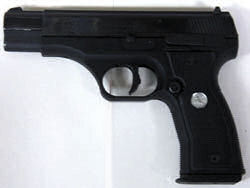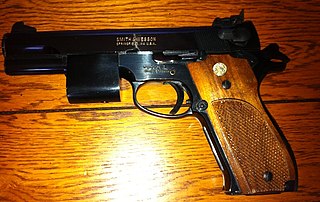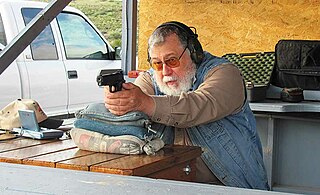
The 10mm Auto is a powerful and versatile semi-automatic pistol cartridge introduced in 1983. Its design was adopted and later produced by ammunition manufacturer FFV Norma AB of Åmotfors, Sweden.

Practical shooting, also known as dynamic shooting or action shooting, is a set of shooting sports in which the competitors try to unite the three principles of precision, power, and speed, by using a firearm of a certain minimum power factor to score as many points as possible during the shortest time. While scoring systems vary between organizations, each measures the time in which the course is completed, with penalties for inaccurate shooting. The courses are called "stages", and are shot individually by the shooters. Usually the shooter must move and shoot from several positions, fire under or over obstacles and in other unfamiliar positions. There are no standard exercises or set arrangement of the targets, and the courses are often designed so that the shooter must be inventive, and therefore the solutions of exercises sometimes vary between shooters.

Massad F. Ayoob is an American firearms, self-defense instructor and security advisor. He has taught police techniques and civilian self-defense to both law enforcement officers and private citizens since 1974. He was the director of the Lethal Force Institute in Concord, New Hampshire, from 1981 to 2009, and now operates his own company. Ayoob has appeared as an expert witness in several trials. He served as a part-time police officer in New Hampshire since 1972 and retired in 2017 with the rank of captain from the Grantham police department in New Hampshire. On September 30, 2020, Ayoob was named president of the Second Amendment Foundation.

Point shooting is a practical shooting method where the shooter points a ranged weapon at a target without relying on the use of sights to aim. Emphasis is placed on fast draw and trying to score preemptive hits first. In close quarters combat, where life-threatening situations emerge very quickly, sighted marksmanship techniques become risky, so advocates of point shooting emphasize a less sighting-oriented style that prioritizes the tactical advantages of quick fire superiority and suppression.

Bowling pin shooting is a shooting sport in which the competitors race against one another to knock standard bowling pins from a table in the shortest elapsed time. Pin shooting is often described as one of the most enjoyable shooting games and one of the easiest means of introducing a new shooter into regular competitive shooting. Pin shooting appeals to both genders. There are many female pin shooters and many distinguished female pin shooters.
The Mozambique Drill, also known as the Failure Drill, Failure to Stop drill, or informally as "two to the body, one to the head", is a close-quarters shooting technique that requires the shooter to fire twice into the torso of a target, and follow up with a more difficult shot to the head that, if properly placed, should kill or otherwise stop the target if the previous shots failed to do so.
A double tap is a shooting technique where two shots are fired in rapid succession at the same target with the same sight picture. Instruction and practice of the double-tap improves accuracy as shooters often do not have the gun fully extended on the first shot meaning the second shot of a double tap is usually more accurate. The term hammer is sometimes used to describe a double tap in which the firearm's sights are not reacquired by the shooter between shots.

L. W. Seecamp Co. was an American manufacturer of pocket pistols located in Milford, Connecticut from 1981 to 2014. In 2014, Whalley Precision purchased the company and took over production of the pistols from their facility in Southwick, Massachusetts.

John Dean "Jeff" Cooper was a United States Marine, the creator of the "modern technique" of handgun shooting, and an expert on the use and history of small arms.

The Colt Commander is a single-action, semi-automatic, magazine-fed, and recoil-operated handgun based on the John M. Browning–designed M1911. It was the first mass-produced American pistol with an aluminium alloy frame and the first Colt pistol to be chambered in 9mm Parabellum.

S&W Centennial is a family of revolvers made by Smith & Wesson on the "J-Frame". Depending upon caliber, the cylinder holds either 5, 6, 7, or 8 cartridges. Centennials feature a fully enclosed (internal) hammer, which makes them Double Action Only (DAO) firearms. Like all other "J-frame" Smith & Wesson revolvers, they have a swing-out cylinder. Centennial models have been made in different versions like PD "Personal Defense", LS "Lady Smith", and M&P "Military & Police"

The Colt 2000 or All American 2000 is a polymer or aluminum-alloy framed, locked-breech, rotating barrel, semiautomatic, 9 mm handgun with a magazine capacity of 15 rounds manufactured by Colt.

SIG Sauer of Newington, New Hampshire, manufactures a full line of 1911 styled handguns. The earliest models were very faithful to the John M. Browning designed Colt M1911 Pistol which became the United States standard sidearm and served in that capacity for some seven decades before being replaced by the Beretta M9 handgun.
The modern technique is a method for using a handgun for self-defense, originated by firearms expert Jeff Cooper. The modern technique uses a two-handed grip on the pistol and brings the weapon to eye level so that the sights may be used to aim at the target. This method was developed by Cooper into a teachable system beginning in the 1950s, based on the techniques of shooters like Jack Weaver, Mike Rousseau and others, after experiments with older techniques such as point shooting. The method was codified in book form in 1991 in The Modern Technique of the Pistol by Gregory B. Morrison and Cooper.
The Smith & Wesson 340PD is an ultra-light J-frame five shot snubnosed revolver chambered for .357 Magnum.
The Smith & Wesson 645 and Smith & Wesson 745 are second-generation semi-automatic pistols which predate Smith & Wesson's 4500 series of handguns. The S&W 645/745 is chambered for the .45 ACP cartridge. The S&W 645 is constructed almost entirely from stainless steel and is thus extremely resistant to harsh weather conditions, whereas the S&W 745 has a stainless steel frame and a blued carbon steel slide. The S&W 645 was introduced in 1985 and discontinued in 1988. The S&W 745 was produced from 1986 to 1990, primarily as a single-action competition gun for IPSC shooting.
A tactical reload is the action of reloading a weapon that has only fired a few rounds out of its magazine, and retaining the original magazine. An example is an infantryman reloading before entering a hostile building, concerned about ammunition. Tactical doctrine states that one should always have a full magazine before entering the building or hostile situation, but it is also a bad practice to throw away ammunition in case it is needed.

The Colt Officer's Model or Colt Officer's ACP is a single-action, semi-automatic, magazine-fed, and recoil-operated handgun based on the John M. Browning designed M1911. It was introduced in 1985 as a response from Colt to numerous aftermarket companies making smaller versions of the M1911 pistol.

The Smith & Wesson Model 52, sometimes referred to as the 38 Master, is a semi-automatic pistol developed by Smith & Wesson for Bullseye shooting. It was one of the first semiautomatic pistols chambered in .38 Special with flush-seated, full wadcutter bullets. The shape of the rimmed cartridge limited the magazine capacity to five rounds. A variant, known as the Model 952, in 9 mm Parabellum, is still produced in limited quantities by Smith & Wesson's Performance Center. The Model 52 was discontinued in 1993 when the machinery to manufacture the pistol broke down and it was deemed too costly to replace.

John August Taffin is an American author from Boise, Idaho who writes several columns for gun magazines including Guns, Gun Digest, Sixgunner, Shoot! and American Handgunner. A former math teacher from 1964 to 1995, Taffin is regarded as an authority on single-action revolvers, handloading, handgun hunting, big-bore revolvers, and metallic silhouette shooting. Taffin has authored five books and over 500 published articles. His monthly published gun columns include: Siluetas, Campfire Tales, The Sixgunner, and Taffin Tests.














